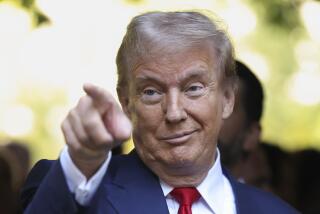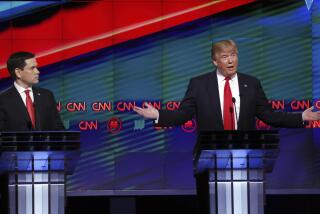Rethinking the Debate Over Trade
The swords have been drawn for a vigorous fencing duel over foreign trade policy. The House of Representatives last month passed a foreign trade bill that would raise barriers to the import of many commodities. President Reagan immediately challenged the legislation, denouncing it as “an ominous anti-trade bill,” “kamikaze legislation” and “destructivism.”
The mats are thus laid for yet another round of parry and thrust in the longstanding contest between free trade and protectionism.
This is the wrong debate. The choice between free trade and protectionist foreign trade policies is outmoded and misplaced. However attractive the familiar rhetorical positions, we should move to a much more constructive and important discussion about longer-term objectives.
The principal problem with the traditional alternatives is that neither offers any fundamental solution to the underlying sources of persistent U.S. trade weakness.
The United States has been losing its competitive advantages in world markets for three decades, not just since the value of the dollar began to soar in 1979. We have fared so poorly in large part because U.S. productivity has grown more slowly than in almost all of the major competing economies, leading to cost disadvantages in international competition. (This problem, and not wage inflation, has been most critical, since long-term wage growth has been slower in the United States than among our major trade competitors.)
Slow Productivity Growth Ignored
Unfortunately, given the fervent attachments that many feel to these two traditional positions, neither the free-trade nor the protectionist approach would address this underlying problem of slow productivity growth.
Protectionism explicitly ignores it, simply raising the drawbridges to reduce the inflow of increasingly attractive imports. The free-trade orientation is no more promising, offering only the hope that more intense world market competition will prod U.S. businesses to shape up or shut down.
While competition in moderate doses can be very stimulative, unregulated and unbridled competition can lead to sharp swings in prices or exchange rates and therefore in expected product demand. That kind of unpredictability is likely to forestall productive fixed investment precisely because investors are most prone to move from durable fixed investments to shorter-term financial investments when the future seems most volatile and difficult to project.
Indeed, despite all the recent intensification of international competition in a world of flexible and sharply fluctuating exchange rates, average productivity growth and the net fixed investment share have been no more promising since 1979 than during the “stagflationary” doldrums of the 1970s.
If not the familiar slogans of “free trade” or “protection,” what instead? Many now recognize that intensive and concerted constructive action--by business, labor and the government--is necessary to promote more rapid productivity growth. The more effective such actions, the more they would help our international competitive position.
With every successful step in that direction, however, we confront a critical choice about how to marshal our improved competitiveness. Should we compete through vigorous export promotion, reinforcing and even extending our dependence on international trade? Or should we seek to substitute quality domestic products for those currently imported, reducing our dependence on foreign trade and enhancing national self-sufficiency?
I call the former approach the “Staying on Top” strategy (after the recent book of that title by conservative analyst Kevin Phillips). Many corporate leaders and neo-liberals have begun to push for more aggressive government policies aiming at export promotion--seeking to increase our share of foreign markets through export subsidies, high-tech R&D; and through international bargaining about access to foreign markets. These proposals are often accompanied by strong insistence on the need to prove that we can “stay on top” and remain “No. 1.”
‘Front Yard’ Strategy
I contrast that approach with an alternative that I call the Front Yard strategy--because it would place priority on tending our own economic gardens, not beggaring our neighbors’. The Front Yard strategy would seek to diminish our dependence on imports by improving the quality and cost competitiveness of domestic substitutes. It would increase national self-sufficiency not by raising barriers to imports but by making domestically produced alternatives more attractive.
The difference in orientation between the Staying on Top and the Front Yard strategies are thus quite dramatic. The Staying on Top strategy would seek to overcome trade weakness and deficits through increased exports--reinforcing tendencies toward a higher trade share in total national product and toward increased trade dependence and increasing immersion in a specialized international division of labor.
The Front Yard strategy would aim in the opposite direction, seeking to address trade problems through import substitution--reducing our dependence on imports by loosening up the constraints imposed by international specialization and eventually by significantly increasing our ability to produce effectively for our own needs. Complete national self-sufficiency is obviously impossible, but there is plenty of room for dramatic movement in that direction.
The contrasts are stark, and the choice between these two orientations is not easy or automatic--certainly not for resolution in a short newspaper column. But one comparative point is essential as introduction to this emergent debate:
I have argued in detail in a recent article in the Atlantic Monthly (“Do We Need to Be No. 1?” April, 1986) that the Front Yard strategy is economically feasible. In particular, modern technology reduces the necessity for detailed international specialization, making it more and more plausible that we can move toward increased self-sufficiency without sacrificing either the quantity or quality of our standard of living.
If that argument is correct--and I believe the case is quite compelling--then economic arguments diminish in relative importance and political considerations become more salient. And it is here, in the political realm, that I think the case for the Front Yard strategy is most resonant.
Movement toward increased national self-sufficiency has two considerable political attractions.
First, it can help moderate pressures to reduce our workers’ economic and political rights to the lowest common denominator of politically oppressive regimes abroad--such as South Korea--where authoritarianism and the chattel status of trade unions, as much or more than some mystical qualities of economic efficiency, help restrain production costs.
Second, it seems fairly obvious that reduced trade dependence would better support the quest for peace and international cooperation than a jingoistic, tub-thumbing campaign for renewed world economic supremacy. Workers’ rights at home and peace abroad are difficult enough to achieve without facing the additional hurdles imposed by international economic warfare.
These are crucial concerns. The choice between the Front Yard and Staying on Top strategies, therefore, is the one we should face and make, not the stale confrontations currently loosening rhetorical vibrato in Washington.
More to Read
Inside the business of entertainment
The Wide Shot brings you news, analysis and insights on everything from streaming wars to production — and what it all means for the future.
You may occasionally receive promotional content from the Los Angeles Times.










